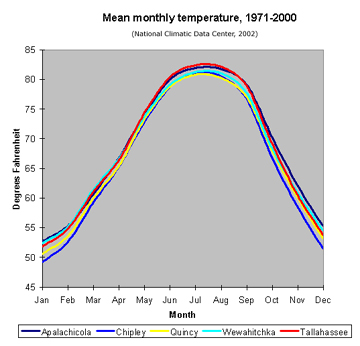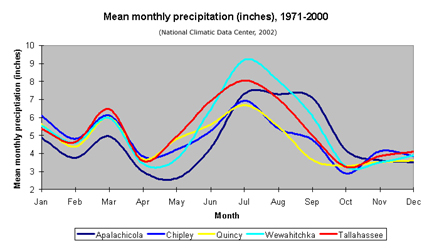|
Land Weather Regional Climate Temp & Rainfall Extremes Storms Climate Change Water |
Weather: Temperature and Rainfall
A few statistics
| Temperature patterns in the ARROW region follow the usual Northern Hemisphere schedule: hottest between June and September, coldest between November and February, and moderate in between. Mean monthly temperatures at the region's weather stations don't vary by much more than 5 degrees Fahrenheit. |
 |
| There's a lot more variation in rainfall in different parts of the ARROW region. (Meteorologists prefer to talk about precipitation, which includes rain, snow, hail, and any other form water may take when it falls from sky to earth.) |
 |
Like the rest of the Panhandle and most of central and northern Florida, the ARROW region has two wet seasons and two dry seasons. The wettest season is summer. In the region's northern counties, July is usually the month that brings the most rain, with another wet season in winter and early spring. The driest month of the year is usually October or November, with a second dry period in April and May. The pattern is different at the Apalachicola weather station, where the wettest month is usually September and the driest is May.
Source: National Climatic Data Center. 2002. Monthly Station Normals of Temperature, Precipitation, and Heating and Cooling Degree Days 1971-2000. 08 Florida. Climatography of the United States No. 81. National Oceanic and Atmospheric Administration, National Environmental Satellite, Data, and Information Service, National Climatic Data Center, Asheville, NC. Available at U.S. Climate Normals.
Note: The content of the website has not been updated since 2005. The site remains online for it's value as legacy content and is unlikely to be updated.